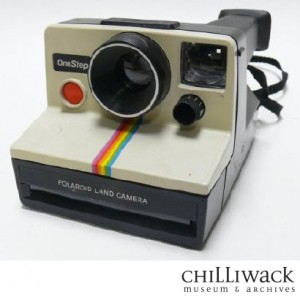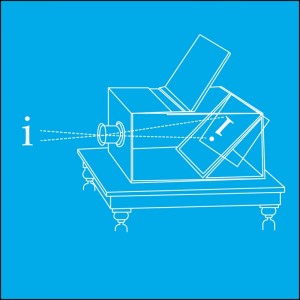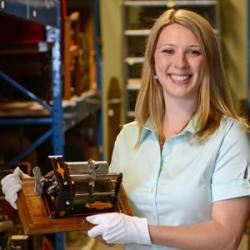
This Polaroid Land Camera was purchased for $6.65 in 1972. This equates to about $45 if adjusted for inflation. Chilliwack Museum and Archives 2003.013.007
Who out there remembers Polaroid cameras? Or film? These technologies seem like a distant memory for many, if not completely unknown to younger generations. Nowadays, you can take a photo on your phone and share it with anyone you want within 30 seconds. There is even an app for taking a photo just to have it disappear!
Our upcoming exhibit, Photography from Obscura to App explores how the developments in photographic processes and techniques have formed how we photograph, what we photograph, and how photography has shaped our perception of the world we live in. Economics is closely linked not only with the development of photographic processes and technology, but also with the esthetic unfolding of photography. There has been a struggle to generate ideas that make photography more inexpensive and more exact, and to give it the most extensive possible distribution. The competition between various technologies and processes that began with the invention of photography in 1839 has resulted in the profusion of easily accessible images we surround ourselves with today.
In the early twenty-first century we are so familiar with the photograph and other technically reproduced imagery, that to imagine a world without these visuals is hard. The invention of photography was such an astonishing achievement in the mid-nineteenth century that perhaps its only imaginable equivalent might be the invention of the internet. Photography now relates to everything within society and art.
Camera Obscura

The first record of the Camera Obscura principle goes back to Ancient Greece, when Aristotle noticed how light passing through a small hole into a darkened room produces an image on the wall opposite, during a partial eclipse of the sun.
One of the first forms of photography was the Camera Obscura, which is essentially a dark, closed space in the shape of a box with a hole on one side of it. The hole has to be small enough in proportion to the box to make the Camera Obscura work properly. The way it works is that due, to optical laws, the light coming through a tiny hole transforms and creates an image on the surface that it meets, i.e. the wall of the box. The image was mirrored and upside down, however, so basically everything that makes today’s analogue camera’s principles different to Camera Obscura ones are the mirrors and the film which is used to capture and preserve the image created by the light.
What other forms of photography are now only in history? Too many to count! Photography from Obscura to App opens on September 22, 2016 at the Chilliwack Museum. Stay tuned for more photographic history throughout the summer.


Comments are closed.